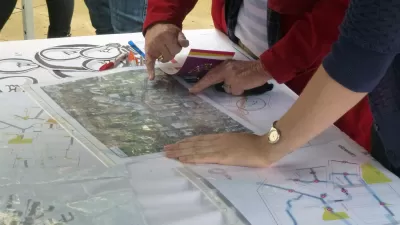While streamlining and anti-NIMBYism are in vogue, Murtaza Baxamusa reminds us what's really at stake.
One person’s certainty is another’s uncertainty. If development projects, especially large developments, attain more certainty through cutting back the administrative and public review process, the result is more uncertainty for impacted neighborhoods and others, warns USC urban planning faculty member and affordable housing developer Murtaza Baxamusa, Ph.D, AICP.
“[T]here is a concerted effort by planners and policymakers locally and statewide, to reduce uncertainty in development project approvals. It takes the form of reducing discretion of public bodies, streamlining permit approvals through the use of specific plans and categorical exemptions, reforming the California Environmental Quality Act, and limiting opportunities for legal challenges to projects.
However, what often occurs under the guise of reducing uncertainty for project proponents is shifting that uncertainty to the many other stakeholders in a project. These stakeholders include elected officials, other regulatory agencies, neighbors, construction suppliers, contractors and building trades, organized labor, community planning groups, neighborhood associations, future residents, future local workforce, nonprofit service providers, and everyone downstream on the environmental impacts of the project.
This shift occurs because there is a cloud of externalities that hovers over most projects, which mushrooms with the scale of the project. These externalities include impacts on regional employment dynamics, increased load on existing infrastructure, stress on the jobs-housing balance, higher utilization of neighborhood services and public safety, disempowerment of minorities, deficiency of strained community amenities and facilities, burden on sensitive receptors within the radius of influence of the project, destruction of historical heritage, industrial waste and toxic emissions, consumption of natural resources, congestion and pollution from automobiles that drive to and from the project, as well as cumulative impacts of growth such as greenhouse gas emissions.”
FULL STORY: In Defense of Uncertainty

Maui's Vacation Rental Debate Turns Ugly
Verbal attacks, misinformation campaigns and fistfights plague a high-stakes debate to convert thousands of vacation rentals into long-term housing.

Planetizen Federal Action Tracker
A weekly monitor of how Trump’s orders and actions are impacting planners and planning in America.

In Urban Planning, AI Prompting Could be the New Design Thinking
Creativity has long been key to great urban design. What if we see AI as our new creative partner?

King County Supportive Housing Program Offers Hope for Unhoused Residents
The county is taking a ‘Housing First’ approach that prioritizes getting people into housing, then offering wraparound supportive services.

Researchers Use AI to Get Clearer Picture of US Housing
Analysts are using artificial intelligence to supercharge their research by allowing them to comb through data faster. Though these AI tools can be error prone, they save time and housing researchers are optimistic about the future.

Making Shared Micromobility More Inclusive
Cities and shared mobility system operators can do more to include people with disabilities in planning and operations, per a new report.
Urban Design for Planners 1: Software Tools
This six-course series explores essential urban design concepts using open source software and equips planners with the tools they need to participate fully in the urban design process.
Planning for Universal Design
Learn the tools for implementing Universal Design in planning regulations.
planning NEXT
Appalachian Highlands Housing Partners
Mpact (founded as Rail~Volution)
City of Camden Redevelopment Agency
City of Astoria
City of Portland
City of Laramie





























